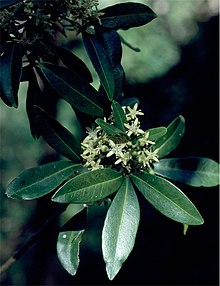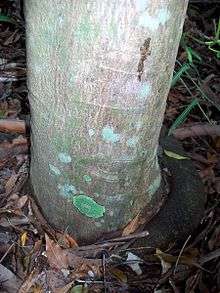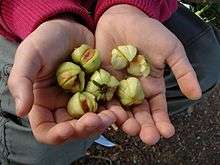Acronychia suberosa
Acronychia suberosa , commonly known as corky acronychia,[2] is a species of small to medium-sized rainforest tree that is endemic to eastern Australia. It has mostly trifoliate leaves with ellitic to egg-shaped leaflets with the narrower end towards the base, small groups of cream-coloured flowers and elliptical to spherical, creamy yellow to whitish fruit.
| Corky acronychia | |
|---|---|
 | |
| In Coffs Harbour Botanic Garden | |
| Scientific classification | |
| Kingdom: | Plantae |
| Clade: | Tracheophytes |
| Clade: | Angiosperms |
| Clade: | Eudicots |
| Clade: | Rosids |
| Order: | Sapindales |
| Family: | Rutaceae |
| Genus: | Acronychia |
| Species: | A. suberosa |
| Binomial name | |
| Acronychia suberosa | |


Description
Acronychia suberosa is a tree that typically grows to a height of 20 m (66 ft) with a stem diameter of 30 cm (12 in) and a thick, dark crown. The trunk is mostly cylindrical, but occasionally with flanges at the base and the bark is usually smooth, brown or red-brown. The leaves are trifoliate, mostly arranged in opposite pairs,the petiole 10–45 mm (0.39–1.77 in) long, the leaflets elliptical to egg-shaped with the narrower end towards the base, 35–85 mm (1.4–3.3 in) long and 9–30 mm (0.35–1.18 in) wide on a petiolule up to 10 mm (0.39 in) long. The flowers are arranged in cymes 18–35 mm (0.71–1.38 in) long, the individual flowers on a pedicel 1–3.5 mm (0.039–0.138 in) long. The four sepals are 2–3 mm (0.079–0.118 in) wide, the four petals cream-coloured and 6–9 mm (0.24–0.35 in) long and the eight stamens alternate in length. Flowering mainly occurs in February and the fruit is a fleshy, creamy yellow to whitish, elliptical to more or less spherical drupe 12–15 mm (0.47–0.59 in) long. The fruit matures from March to June.[2][3][4]
Taxonomy
Acronychia suberosa was first formally described in 1932 by Cyril Tenison White in Proceedings of the Royal Society of Queensland from specimens collected in Lamington National Park in 1929.[5][6] The specific epithet suberosa means corky, referring to the bark on older trees.
Distribution and habitat
Corky acronychia grows from the Richmond River, New South Wales to just over the border at the McPherson Range in south eastern Queensland at altitudes of 200–1,000 m (660–3,280 ft). The habitat is sub-tropical or warm temperate rainforest on basalt soils in high rainfall areas.[2][3][4]
Uses
Food
The fruit is edible but acidic.[7]
Horticulture
Removal of the flesh from the seed is advised for regeneration. Around 30% of the seeds may germinate in five months.[3]
References
- "Acronychia suberosa". Australian Plant Census. Retrieved 7 July 2020.
- "Acronychia suberosa". PlantNET - NSW Flora Online. Retrieved 2010-11-29.
- Floyd, A. G. (2008). Rainforest Trees of Mainland South-eastern Australia (2nd, Revised ed.). Lismore, New South Wales: Terania Rainforest Publishing. p. 349. ISBN 0-958943-67-2. Retrieved 2010-11-28.
- Hartley, Thomas G.; Wilson, Annette J.G. (ed.) (2013). Flora of Australia (Volume 26). Canberra: Australian Biological Resources Study. p. 108. Retrieved 7 July 2020.CS1 maint: extra text: authors list (link)
- "Acronychia suberosa". APNI. Retrieved 7 July 2020.
- White, Cyril T. (1932). "Two previously undescribed Rutaceae from south eastern Queensland". Proceedings of the Royal Society of Queensland. 43: 47–48. Retrieved 7 July 2020.
- "Food Plants International".
